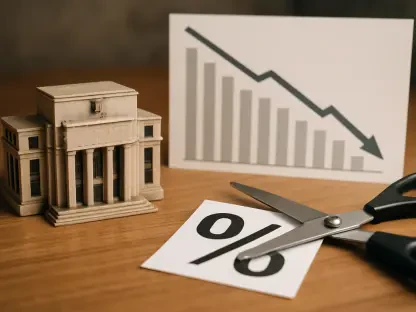Priya Jaiswal, esteemed for her profound expertise in banking and finance, offers insightful perspectives on the dynamics of personal loan interest rates and how various factors influence them. This conversation promises to shed light on significant trends impacting borrowers and financial institutions alike, providing readers with valuable knowledge to navigate the evolving landscape of personal finance.
What are the current average personal loan interest rates in 2025, and how have they changed from last week?
Average personal loan rates are currently at 20.78% APR in 2025, which is noticeably higher than last week’s figures. This variation could be attributed to economic conditions, shifts in lender policies, or changes in borrower demand. Understanding these rates requires a grasp of broader financial trends and individual credit standings, which are pivotal in determining the specific rate a borrower might receive.
How do personal loans generally differ in terms of purpose, and what are some common uses for them?
Personal loans are quite versatile and cater to diverse needs ranging from weddings, home renovations, dental work, to even covering income taxes. While they can be used for any number of personal expenditures, debt consolidation is a particularly popular reason borrowers seek such loans. This flexibility makes personal loans an attractive option for many looking to manage large expenses efficiently.
Can you explain why debt consolidation is a popular use for personal loans, and which lenders specialize in this?
Debt consolidation is favored because it simplifies managing multiple debts by combining them into a single loan, often with a lower interest rate than existing debts. Lenders like Happy Money and Reach Financial specialize in offering debt consolidation loans, providing borrowers a streamlined repayment process and potentially saving them money on interest. This focused assistance can alleviate financial stress significantly.
Who typically qualifies for the best low-interest personal loans, and what factors influence the interest rates offered to borrowers?
Borrowers with excellent credit typically qualify for the most competitive, low-interest personal loans. Lenders evaluate risk mainly through credit scores, income stability, debt-to-income ratios, and previous borrowing history. These factors help lenders determine the likelihood of timely repayment. A stable financial profile generally assures lenders, leading to better rates for these borrowers.
What are some of the lowest APRs available among the lenders mentioned, and which companies are offering them?
Some of the lowest APRs among the tracked lenders include Reach Financial starting at 5.99%, LightStream at 6.49%, and American Express at 6.90%. These figures highlight the competitive nature of lenders striving to attract high-credit-profile borrowers by offering favorable rates to lower their overall cost of borrowing over the loan’s life.
How does a borrower’s credit score impact the personal loan rates they might be offered?
A borrower’s credit score is a critical determinant of the loan rate offered by lenders. Higher scores suggest a lower risk to lenders, often resulting in more favorable interest rates. Conversely, lower scores may prompt higher rates to compensate for the perceived risk. Maintaining good credit is therefore crucial in securing affordable borrowing terms.
What role does the Federal Reserve play in influencing loan rates across the economy?
The Federal Reserve significantly influences loan rates through its monetary policy, primarily by adjusting federal funds rates. These adjustments affect the borrowing costs for banks and consequently the interest rates they offer consumers. The Fed’s interventions either stimulate economic activity or control inflation, thus indirectly impacting personal loan rates available in the market.
How do current economic conditions affect loan rates, particularly during periods of economic growth versus recession?
In periods of economic growth, there’s typically a higher demand for loans, which can lead lenders to raise interest rates. During recessions, loan demand tends to drop, and lenders may reduce rates to encourage borrowing and stimulate activity. These cycles reflect how economic conditions pulse through the lending ecosystem, directly affecting rate availability and affordability.
Could you explain what an annual percentage rate (APR) is in the context of personal loans and why it’s important for borrowers to understand?
APR encompasses the total cost of borrowing, including interest and any associated fees, giving borrowers a clearer picture of what they’ll pay over the loan’s term. Understanding APR is crucial as it provides a comprehensive comparison point between different loan offers, ensuring borrowers choose the most cost-effective option.
What factors do lenders consider when determining personal loan rates, and how can borrowers improve their chances of qualifying for lower rates?
Lenders examine credit scores, income stability, debt-to-income ratios, and the borrower’s repayment history. To improve eligibility for lower rates, borrowers should focus on building strong credit profiles, paying down existing debts, maintaining stable income, and possibly exploring co-signing options to mitigate perceived risks.
How do fixed and variable interest rates differ in terms of their impact on loan repayment?
A fixed interest rate remains constant throughout the loan term, providing predictability in repayment amounts. Conversely, a variable rate fluctuates with market conditions, potentially offering lower initial rates but unpredictability over time. Borrowers must weigh stability versus potential savings when choosing between the two.
What credit score is typically needed to qualify for the lowest interest rates on personal loans?
Typically, a credit score of 700 or higher is required to access the lowest interest rates on personal loans. This high score suggests a strong credit history, low risk, and reliability, encouraging lenders to offer more favorable terms.
How does a borrower’s debt-to-income ratio affect their loan eligibility and the rates they’re offered?
A lower debt-to-income ratio is preferable as it demonstrates a borrower’s capability to manage debts while taking on new loans. It’s often a key metric for lenders when evaluating applications for competitive rates. Higher ratios can signal financial strain, prompting higher rates or even denial of loan requests.
Can you provide tips or strategies for improving one’s chances of loan approval and obtaining a lower interest rate?
Focus on reducing debts to lower your debt-to-income ratio, build a stronger credit profile by paying bills promptly, and resolving any credit report errors. Additionally, having a co-signer with better financial credentials might help secure favorable terms.
How do short-term loans compare to long-term loans in terms of interest rates, and why might they differ?
Short-term loans typically offer lower interest rates due to the reduced risk associated with quicker repayment periods. Long-term loans, conversely, carry higher interest rates to compensate for the increased risk of extended repayment schedules and potential market changes over time.
What are the differences between secured and unsecured personal loans, and how do these differences impact interest rates?
Secured personal loans, backed by collateral, offer lower interest rates as they present less risk to lenders. Unsecured loans, lacking collateral, come with higher rates due to the increased risk profile. Borrowers with assets to secure their loans often benefit from more favorable terms.
Where can borrowers generally find the best interest rates—online lenders, traditional banks, or credit unions—and why?
Online lenders typically offer the most competitive rates due to lower operating costs and flexible terms. Credit unions also provide attractive rates given their nonprofit model and member-focused policies, while traditional banks may offer dependability but often at slightly higher rates.
What are some potential pros and cons of securing a low-interest personal loan?
Pros include reduced borrowing costs and manageable repayments enhancing credit scores over time. However, eligibility criteria can be stringent, and associated fees might increase the loan’s overall cost. Also, low-interest options may entail longer approval processes.
Could you walk us through the steps involved in applying for a low-interest personal loan?
Start by checking your credit score to ensure you meet lender requirements. Gather financial documentation, compare offers from various lenders, calculate your desired loan amount, and complete applications accurately. After receiving offers, review terms carefully, accept a suitable loan, and proceed with timely repayments.
What are common mistakes applicants should avoid during the personal loan application process?
Avoid skipping credit report checks for discrepancies or applying to too many lenders simultaneously, which can lower credit scores through hard inquiries. Focusing solely on interest rates without considering fees or repayment terms is another common error.
What actions can a borrower take if they’re denied a personal loan?
Begin by understanding the reasons for denial, correcting any credit report inaccuracies, and working to improve credit scores or debt ratios. Exploring secured loans, alternative lenders, or adding a co-signer can also be effective strategies to mitigate previous issues.
How do balance transfer credit cards compare to low-interest loans as an alternative option?
Balance transfer cards offer short-term interest rate advantages, often at 0%, presenting a viable debt consolidation tool. However, after the introductory period, rates increase. Low-interest personal loans provide consistent rates over the term, offering long-term stability.
What are the risks and benefits of using home equity loans or HELOCs as alternatives to personal loans?
These options often carry lower interest rates due to their secured nature but pose significant risks, such as potential foreclosure if defaults occur. They prove beneficial when financing large expenditures but require a careful assessment of repayment capacities to soften risks.
How does peer-to-peer lending work, and why might it be a cost-effective borrowing option?
Peer-to-peer platforms connect borrowers directly with individual investors, often offering competitive rates by bypassing traditional banking structures. This streamlined approach can reduce costs for both parties, though borrowers must consider platform fees and varied lender criteria.
Do you have any advice for our readers?
Remain vigilant about maintaining a robust credit profile and assessing the total loan cost beyond interest rates. Additionally, explore various lenders and loan products to identify the best financial fit for your unique needs, and never underplay the significance of financial literacy in shaping favorable borrowing outcomes.









